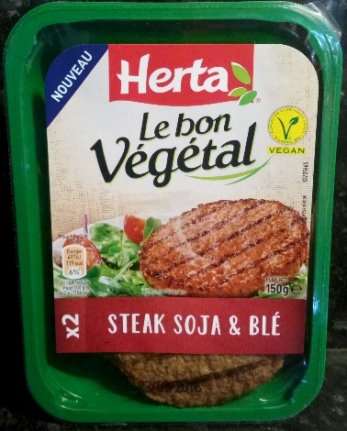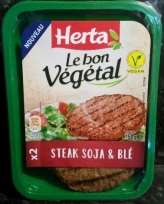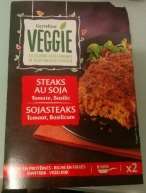Herta Company: Product Improvement Analysis and Plan
| ✅ Paper Type: Free Essay | ✅ Subject: Business |
| ✅ Wordcount: 4277 words | ✅ Published: 14 Sep 2017 |
Report Title: A Study of a soy and wheat steak by the brand Herta in France
Summary
The question of meat consumption is raised in almost every country in Europe. People are starting to reduce their meat consumption for various reasons such as its price, ethics, health or environment. Hence, the industry has to adapt and create an answer to that new demand. Some brands like Herta, a traditional cold meat brand company has created a new Vegetal range. The aim of this report is to study a soy and wheat steak from the brand Herta in France.
First, the report will focus on an overall market situation of a product involving desk research of the current market situation and a focus group to evaluate the perceived quality of the product. The second part of the report will suggest a plan for product improvement, presenting variations that could be done to improve the product and its sales. In order to do that, a small survey was done to understand better the needs and the worries of the population who can potentially buy such a type of product.
2.1 – What is Herta?
The product of the Brand “Herta” is a soy and wheat steak. It belongs to a range of products called “Le Bon Végétal”, meaning “The Good Vegetal”. Herta is an industrial brand owned by Nestlé. It is famous for its pre-cooked “Frankfurter”, which is a seasoned smoked sausage made of beef and pork. Herta is currently the number one Frankfurter-brand throughout Europe, but not only that. Herta has an awareness rate of 96% and a penetration rate of 83% in France, and is the first brand of cold meats and has been the first brand overall in France for 3 years according to the Kantar World panel.
Its position on the market has always been one of simplicity, and it has insisted a lot on this with its slogan “The taste of simple things” since 2012. Herta does the majority of its activity on the cold meat market with 60% of its sales in volume. It also sells fresh deli products. Recently, the brand announced an innovation which has broken with its usual business portfolio : the range “Le Bon Végétal”.
According to Sophie Van Eeckhaute, brand manager at Herta, this new product is the latest strong undertaking of the company. Usually the market is only owned by specialists, but Herta wants to “democratize the vegetal protein”. While this product seems unusual for the brand, she highlights that Nestlé is not new in this field since it owns “Krupa”, a product facility for production of such products. “Le Bon Végétarien” has more than 10 different recipes elaborated with vegetal proteins and each product is sold for around 2,75 € with a weight of 150 to 200g.
With this new product, Herta is aiming at “flexitarians” (30% of the population in France) who try to reduce their meat consumption, but also to vegetarians, who don’t eat meat (2%) and vegans, who don’t eat product from animals (0,5%). Herta wants to attract 30% of the vegetarian catering market of supermarkets. It is aiming at families who want to eat healthily and who want to reduce their consumption of animal proteins according to Catherine Petilon, marketing director at Herta. In Nestlé’s opinion, the offer of fresh deli products doesn’t fit with the needs of the French consumers. The consumers don’t really know the brands which are positioned on the market of vegetal protein foods such as Sojasun, Céréal and Carrefour Veggie. The marketing director is convinced that Herta has a role to play on this market thanks to its notoriety. Indeed, the brand bets on its proximity to the meat market to erase the concern of a part of consumers to eat vegetal meat. (Prodimarques, 2016)
2.2 – What does the product consist of?
All the products from the range “Le bon Végétal” come with the European Label V with the mention vegetarian or vegan. However, it doesn’t say anything about the presence or absence of GMO soy despite the fact that Herta assures that they only use non GMO soy.
Focusing on the Soy and wheat steak:
Figure 1 Picture of Herta’s product
Here is the list of ingredients: Soy proteins and rehydrated wheat proteins, water, vegetal oils, onions, corn starch, stabilizers E461, E407; salt, maltodextrin, yeast extract, aroma, onion powders, garlic powders, malt extract, caramel, spices, acidifier: E330. May contains eggs, sesame, celery and mustard.
Table 1 Nutrition value of the soy and wheat steak by Herta
|
Typical value |
For 100g |
Per portion (75g) |
% of recommended daily allowances |
|
Energy |
158 kcal |
119 kcal |
6% |
|
Proteins |
16g |
12g |
24% |
|
Fat (total) Saturated fatS |
6g 0,7 |
4,5g 0,5g |
6% 3% |
|
Carbohydrates |
8g |
6g |
2% |
|
FibreS |
4g |
3g |
– |
|
Salt |
1,5 |
1,1g |
19% |
(Source: OpenFoodFacts, 2016)
2.3 – What is the situation of the market?
The brand wants to establish itself in the niche of Vegetal meats which has a penetration rate, of 8,4% with only 4 purchases per year. But the sales are increasing by 10% each. Herta estimates that the sales are going to be multiplied by two within 2 years. In Germany, this market already represents 140 million of euros, while it is still only 28 million in France.
The fresh deli products belonging to the “vegetarian” category like soya steaks have seen their sales increased by 11.9 % in mass retail in 2015 to reach 15.42 billion euros, according to IRI. Soy based products account for 2/3 of the sales. Over the same period, the overall fresh deli product market has also seen an augmentation of 5,6 % of its sale revenue. However, the average price of a vegetarian product decreased by 0.5% to 14,13 euros per kilo, while the average price of fresh products increased by 1,8% to 10,49 euros.
2.4 – What is the situation of the product on the market?
At the moment, there is no study available about the sales of the product and the sales of competitors. The market is still relatively new in France, and the company is not ready to reveal its sales figures.
2.5 – Overall situation of the society
Over the last years, significant changes have occurred in French food consumption habits. French people tend to eat more at home and in less time (according to euromonitor). But french people also spend less time cooking and want to eat more healthily at the same time. However, these differences of consumption also depend on criteria such as age. Hence, young adults (18-34) consume more processed foods than older people. They also use more delivery services and eat out more often. Besides, the generation born between 1977 and 1986 spends 8 times more money on processed food than the generation from 1920-1930 at the same age. This food consumption is the result of new aspirations which can be ethical, ecological, etc. This generation has to deal with the contradictions of the recommendations of nutrition from professionals and the pressure of the marketing of the government and of the food-business (Study from Agrimer: national French establishment of agricultural products, 2012).
Therefore, 56% of the French say that they eat less meat compared to previous years. For 46% of interviewed people, this is because ‘meat is too expensive”. 35% say that ‘industrial breeding doesn’t respect animal welfare’ and 31% that ‘meat is not good for health’. Then, 26% quote the food scandals and 19% the respect of the environment. Among this panel, 61% eat meat at least once a day and 9% eat meat less than once a week. Now, 30% of French people are qualified as ‘flexitarian’. According to Terra eco (a specialized magazine), 26% of French people would be ready to become vegetarian.
1/2 French people occasionally consume vegetarian products and 1/5 vegan products. 1/5 declares themselves to be neo vegetarian. Nevertheless, 2/5 never have a meal without meat or fish. The profile of the typical vegan consumer is female, young and from a higher Socio-Professional Category. Above all, they look for healthy balanced and natural foods, which also respect the animal welfare, and also mistrust the food-industry. However, neo vegetarians prefer organic shops and brands. They also buy more in small local shops, sometimes up to twice as much as in supermarkets. (according to a report from arcane research).
2.6 – Who are the main competitors? What are the main differences?
To better understand the market, it is important to understand who the other competitors are. There are two different types of competitors: the ones from specialized shops, whose products have ‘created’ the market, and the others which are sold in the same conditions as Herta’s products and are more direct competitors.
La Vie Claire:
La Vie Claire is a chain of organic food stores. Product’s from La Vie Claire are only sold within their shops. They sell a very wide range of products which can substitute meat.
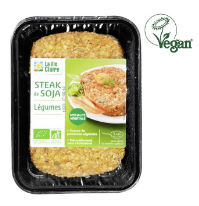
Figure 2 Picture of La Vie Claire’s product
Table 2 Nutrition value of the soy steak by La Vie Claire
|
Characteristics |
Benefits |
Disadvantages |
|
Medium price: 3.50 € for 180g |
Large range of product |
Only available in “La Vie Claire’s shops |
|
Positioning: Specialized Food |
From real soy grains |
Too much fat: 22g against 6g in Herta’s product |
|
From Organic Agriculture |
Not enough proteins: 11,6g against 16g in Herta’s product |
|
|
The product can be seen |
Only 270 shops |
|
|
minimalistic Packaging |
(Source: La Vie Claire, 2016)
La Vie Claire is not a direct competitor since their productS can’t be found next to Herta’s. However, indirectly it will challenge X Herta’s brand and attract a part of the vegetarian and vegan consumers. The product benefits from the very good image of the brand which is seen as more trustworthy in this field, and whICH is specialized in this type of product. That is the reason why the product can be a little more expensive (2.91€ per 150g). Nevertheless, the visibility of the product is far smaller than Herta’s and the product seems to have some nutritional issues since it can’t really be a substitute for meat since there are not enough proteins in it, and that it contains also far too much fat.
“Grill vegetal by “Céréal”:
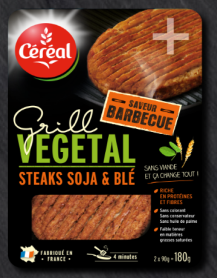
Figure 3 Picture of Cereal’s product
Table 3 Nutrition value of the soy and wheat steak by Grill Vegetal
|
Characteristics |
Benefits |
Disadvantages |
|
Medium price: 3.07 € for 180g |
Large range of product: 7 |
Rehydrated soy and wheat |
|
Positioning: Specialized Food |
A little more fat and mostly unsaturated: 8,5g against 6g in Herta’s product |
Unknown by most consumers |
|
6,1g of Fibers |
Only sold in specialized shops |
|
|
The product can be seen |
||
|
minimalistic Packaging |
||
|
Looks more like meat by the aspect and the packaging |
||
|
Made in France |
||
|
Specifies the absence of additives such as food colourings and preservatives. |
||
|
Good amount of proteins : 17g against 16g in Herta’s product |
(Source: Grill Vegetal, 2016)
Just like “La Vie Claire”, “Grill Vegetal” by “Céréal” is only sold in specialized shops. However, it
is overall a good product with a lots of advantages such as its nutritional aspect, its place of production, and the price is even lower than Herta’s (2,56 € per 150g). The product seems to respond well to the consumers’ demand on all highlighted points by consumers. It also looks like meat and has a decent amount of proteins even if it is still less important than meat. Nevertheless, the rather poor visibility of the product may hold back its consumption.

Figure 4 Picture of Sojasun’s product
Table 4 Nutrition value of the soy steak by Sojasun
|
Characteristics |
Benefits |
Disadvantages |
|
Medium price: 3.50 € for 200g |
Large range of products: 11 (7 steaks) |
Rehydrated soy |
|
Positioning: Supermarkets |
A little more fat and mostly unsaturated: 8,5g against 6g in Herta’s product |
The real product can’t be seen at all |
|
5.0g of Fibers |
||
|
As many proteins as Herta’s (16g) |
||
|
Soy cultivated in France |
||
|
No GMO |
(Source: Sojasun, 2016)
Sojasun’s products are more direct competitors to Herta since they are also sold in supermarkets. The nutrition value of the steak is very similar to Herta’s regarding the protein, fat or fibre amount. However, they have an important range of products and even have 7 different soy steaks. The strong points of the product are the absence of GMO and the origin of the soy. The price is even less expensive than Herta’s with only 2,63 € per 150g. Despite all its strength, the product may suffer from its brand not being as famous as Herta.
‘Veggie’ by Carrefour:
Figure 5 Picture of Carrefour’s product
Table 5 Nutrition value of the soy steak by Veggie (Carrefour):
|
Characteristics |
Benefits |
Disadvantages |
|
Medium price: 2.20 € for 200g |
Large range of product: 16 |
Rehydrated soy |
|
Positioning: Carrefour Supermarkets |
A little more fat and mostly unsaturated: 8,8g against 6g in Herta’s product |
The real product can’t be seen at all |
|
6,6g of Fibers |
The product can only be bought at Carrefour |
|
|
A little less protein than Herta’s (14g). |
||
|
Does not communicate on the origin of the raw products |
(Source: Veggie, 2016)
‘Veggie’ was created by Carrefour in 2015 to become a competitor to Sojasun. They chose to have a very low price in comparison to other similar products. As a consequence, the quality seems to be a little lower. However, the range of products is very large and Carrefour is of great renown in THE food business and distribution. Therefore, ‘Veggie’ may become an important competitor to Herta despite being only sold in Carrefour’s supermarkets.
2.7 – Perceived quality of the product:
A focus group of 6 people have been conducted on the subject of Herta’s new range, and more particularly the soy and wheat steak. The participants were all between 20 and 24 years old and were postgraduate students. This panel was selected because it was composed of 3 men and 3 women, and because more educated people tend to be the major consumers of this type of product according the studies.
Among the panel, only 2 people had tried vegetal meat. They are not common users but said that they ‘rather enjoyed’ the product. All of them said that they would buy the Herta’s product. Half of them said spontaneously that they liked the packaging. They also agreed on the fact that green was a simple but good choice of colour since it seems more ‘natural’. However, none of them knew that Herta had made a new vegetal brand, and it was a bit hard for them to associate Herta with vegetal product. Still, what concerned them the most about the product was the “vegan” tag. They found it very restrictive in a way that in may repel them.
When the benefits of the products were asked, half of them talked about gas emission. Also, the group was very divided concerning the question of animal and vegetal proteins. Some of them fought proteins from animal were better while other said the exact opposite, and some did not intervene. Regarding the drawbacks of the product, they highlighted that the soy production was done in Brazil and that is was not as good as pretended for the environment. Moreover, they associated the soy from Brazil with GMO soy. They also argue about the transformation process and the factory work carried out to get the product and said it was not good for the environment neither, and that the people working in this factories were probably not paid enough. Before the nutrition value topic could have been addressed, they asked for the tag to get a clear idea of what was inside the product. To do a comparison, they also asked for the tag of a real steak. They concluded that there were more proteins in meat and less fat in vegan steak. Moreover, they pointed out the higher concentration in salt and carbohydrates in the Herta product.
Concerning the price, the opinions were very mixed. Some would pay between 3 and 3.5 euros while others would only pay around 2 euros. Those who were ready to invest less money told that they would start by comparing the price with other competitors.
To conclude on the session, one of the major issue with the product was the “vegan” writing which was considered as “too extreme” by the panel. It seems that people may not be ready to go from meat diet to “vegan diet” even if this not on regular basis. The psychological impact of the word on people could repel them from the product. Also, the image of the brand is really associated with meat in the mind of the consumers, it will be something to work on for Herta. Moreover, whereas everyone knew Herta very well, none of them knew the “vegetal” range of product. Hence, it seems that the communication around ‘Le bon végétal’ could be improved. Nevertheless, the product looked appealing for everyone, even if they had restraints about the conception of the product.
2.8 – Conclusion of part 1:
Herta is clearly trying to anticipate the future trends. The brand understood that an important part of the future of fresh deli food relies on meat substitutes, and chose to be part of this new market rather than opposing itself to the new ways of consuming. Being one on of the first on the market could also help Herta which is now an old French brand and need to show innovation to keep a dynamic image in the eye of the consumer.
The major issue for them is to succeed to support the maximum of consumers to this changing without losing them on the path. However, other brands such as Veggie may be fierce competitors for the future, not to mention the other brands already positioned in the market.
3.1 – A lack in terms of nutrition value
The first thing that could be a problem for the future of the product is the quantity. indeed, the pack contains 2 steaks weighing only 75g each which means a total amount of soy and wheat of 150g. for herta’s product, for 100g, there are exactly 150 kcal, corresponding to only 112,5 kcal for 75g.
a beef steak in france has an average of 20g of proteins and between 5 to 15g of fat according to the steak (per 100g). often a steak weighs 125g meaning that is has even more proteins and fat in it. for a steak of only 100g and 10g of fat, there are 170 kcal. The difference in calories is very important and could cause a difference in the perception of satiety especially given that animal proteins give a more important feeling of satiety (Douglas Paddon-Jones., 2008). If the consumer after consuming the product is still hungry, it will affect its experience and he will be less likely to buy it again.
moreover, all competitors use a quantity which varies between 180 and 200g while some of them focus more on the ‘product of high quality’ aspect (grill vegetal, la vie claire) and are seen as less ‘accessible’ products. If a comparison was to be made, it would probably weaken the position of herta who wants to be closer to the average person. The price is indeed higher than other competitors’ price if the calculation is proportional to the quantity. the results are even more disconcerting when comparing carrefour (1.10 € per 100g) and herta (1.83 € per 100g).
keeping the price in the average of the competitors is very important for the brand. if people have the choice between sojasun’s product and herta’s product and consider them to be at the same price if considering the quantity, in would surely harm herta. the significant price difference of veggie by carrefour and herta is too important. the product from ‘le bon végétal’ could be negatively affected by this competition. indeed, the main reason why people tend to consume less meat is the cost. 46% percent of the people who eat less meat are motivated by the price (according to a study lead by Mediaprism).
3.2 – Consider adding information to the packaging
Concerning GMO, if the brand actually uses non GMO soy, it will probably be better to write it on the packaging, even if it is not highlighted. Indeed, as the focus group showed, people are concerned about the origin of the product and particularly soy. This is an important question considering there are not much French soy production.
Moreover, the product has a rather high proportion of proteins compared to competitors and also a low level of fat. The brand should therefore consider writing a slogan such as “the benefits of meat without its disadvantages”. Then, on the other side of the packaging, the brand should explain how the product is better for health thanks to its nutritional value, but also how it is good for the environment. However, while doing that, the brand should always consider its positioning and should not be too harsh with the meat industry since it is Herta’s main revenue sources. However, if the brand judges it too dangerous, another possibility would be to just compare the nutritional value to the products of the competitors and praise Herta’s product.
3.3 – A survey for more accuracy
To get a more accurate idea, a survey was made. This survey was addressed to people who are living in France. These people are mostly between 18-25 years old and are of a rather high education level. The first part of the survey is about questioning the connotation of the terms “Vegetarian” and “Vegan” to understand what people associate with these words and if they sound rather positive or negative.
Hence, to the question “What does the word “vegetarian” actually bespeak?”, people tend to give a definition of the word for the vast majority of them. To the question “What is the connotation associated to the word vegetarian for you?”, more than 55% have a “rather good” to “good” opinion of the idea. Half of the rest is neutral while the other half has a negative idea of the word. However, to the question “What does the word vegan actually bespeak?” the majority tends to give a definition, while a significant number of people (around 25%) associate it with the notion of “extremism”, and that by themselves, only responding to an open question. What is even more astonishing, is the connotation of the term “vegan”, especially in comparison of the results of the same question with “Vegetarianism”. Therefore, around 65% of people have a “rather negative” to “negative” opinion of the word, while almost all the others have a neutral opinion of it. The significant difference between the two terms in people’s mind is confirmed by the question “would you buy vegetarian/vegan products?”. 65% of people would buy vegetarian product while only 50% would buy a vegan product.
The second part of the survey focused on the product and the perception people have of it. To the question, “would you buy this product?”, showing only the picture of Herta’s product, only 28% of people would buy it. This percentage is very weak and lower than what could have been expected. The following question asked to justify the choice helps to get a better idea of what people really think. The people who would not consume the product justify their choice with multiple reasons. One of them is the brand itself. Surprisingly, while it has a very good image among French people, some of the people interrogated said that they don’t trust Herta to make a Vegetal product. Moreover, several people are reluctant to consuming soy. Other people don’t have any interest for the product and a significant number actually doesn’t like the “shape” of the product. They say that if they want a steak, they would buy a steak with meat, and not a substitute.
Finally, this part deals with the price people would be ready to pay for the product. The results are rather homogeneous since every person who responded to this question would invest between 2 to 3 euros for the product. This result is very close to the actual price of the product. To get more precision, the last question was exactly the same but showing two other products from direct competitors: SojaSun and Veggie by Carrefour while also communicating their prices (respectively 3.50 euros and 2.20 euros). This question was askeed to put the people in a more real context where they can have access to other products. Hence when considering only people who would be ready to buy the product, the large majority of them would pay 2.50 euros for it while very few of them would be ready to invest more or invest less money in the product.
3.4 – Analysis of the results
The results that emerge from this survey confirm that the actual price is close to what people would be ready to pay for and that maybe the product could benefit from a slight decrease of its price. Indeed, Herta is a brand for everyone, it cannot be as expensive as another brand of higher range products such as SojaSun or some other specialized competitors. Nevertheless, the price of Carrefour Veggie seems very low and most of the people were ready to invest a little more money in Herta’s product than in Veggie after having seen the price of the product by Carrefour.
Also, the “Vegan” tag question raised after the analysis of focus group was more thorough explored with the survey. It is clear that the concerns shared by the focus group were also shared by the surveyed people. The connotation of the term “vegan” and the associations made around it give it a less appealing look than “vegetarian”. I would therefore advise to change “vegan” for “vegetarian”. In addition, some people seem a bit reluctant when it comes to soy. Keeping a good range of products where not all vegetal products come from soy seems a good idea.
Despite the consistency of the results, the panel was only of 20 people. This means that the results are not completely reliable and should be treated with the utmost care. Carrying out another study by the group Herta on a more important population should en
Cite This Work
To export a reference to this article please select a referencing stye below:
Related Services
View allDMCA / Removal Request
If you are the original writer of this essay and no longer wish to have your work published on UKEssays.com then please click the following link to email our support team:
Request essay removal